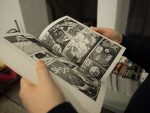Junji Ito, acclaimed author of Japanese horror manga, is known for his impressive ability to craft stories that are at once darkly wonderful and yet strangely believable. Whether it is a young man haunted by his family legacy in “My Dear Ancestors” or a teenage girl whose beauty masks an inner darkness in “Tomie,” Ito excels at creating surreal and nightmarish worlds with uncanny ties to our own. But perhaps nowhere do his works’ parallels with the real world become more frightening than with “Gyo,” a horror series about a bizarre and terrifying threat that, though inhuman at first glance, is entirely man-made.
“Gyo” concerns a young couple, Tadashi and Kaori, whose vacation to the beach in Okinawa takes a sinister turn. One night, after his girlfriend complains of a terrible smell, Tadashi searches their house only to discover what looks like a fish with four metal legs. Although the fish appears to be dead and rotting, it continues to move even after Tadashi crushes it behind a dresser.
The strange fish emits a horrible, foul-smelling gas, a sinister miasma that comes to be known as “the death stench.” Kaori, who is particularly conscious of the death stench due to her hypersensitive sense of smell, orders Tadashi to get rid of the disgusting creature. However, the fish soon escapes, and when Tadashi follows it out to the edge of the sea, he witnesses more four-legged sea creatures begin to emerge from the water.
What soon happens is a full-on invasion of coastal Japan by gas-emitting, biomechanical marine life that can walk upon the land. While perhaps sounding like something out of a B-movie, the results are frighteningly realistic. Mass panic erupts as city after city is overrun by hordes of the monstrous sea creatures. Many unfortunate citizens are trampled to death underneath the needlepointed legs of the “walking fish.” The air is quickly polluted with the death stench, while large undersea predators, seemingly immune to all firearms, begin to stalk their new human prey.
Tadashi and Kaori themselves barely survive an encounter with a land-dwelling shark, whereupon Tadashi is given a chance to inspect the creatures closer. He notices that their legs are part of an apparatus, which also features tubes connected to their gills. These tubes seem to be pumping the foul-smelling gas into the creatures, somehow keeping them alive after death.
Tadashi’s uncle, the scientist Doctor Koyanagi, soon explains the origin of the creatures. During World War II, the Japanese army conducted experiments with an unusual strain of bacteria, which caused its hosts to produce a deadly, pungent gas that infected anyone who inhaled it. Koyanagi’s own father designed the “walking machine,” an apparatus powered by the gas itself that would allow the bacteria’s hosts to spread the pathogen further.
When enemy aircraft bombed the ship carrying the prototypes for the walking machines, it was thought that they were lost. Unfortunately, this was not the case.
The infected sea creatures of “Gyo” are thus the product of a powerful biological weapon that has gone rogue, a weapon that has now begun to destroy the very country it was meant to protect. The destruction wreaked by the walking fish can hence be compared to the troubles caused by other weapons of mass destruction (WMDs), from the terrible loss of life and environmental damage inflicted by sulfur mustard and Agent Orange to the world-ending calamities nearly caused by nuclear weapons.
Indeed, the death stench bacteria quite likely draws inspiration from a number of different WMDs, including the similarly deadly pathogen anthrax and the neurotoxin sarin. Considering “Gyo” was written around the time of the Tokyo subway sarin attacks of 1995 as well as the earlier repeated anthrax attacks made by the same cult, it would make sense that Ito had these events in mind while creating the manga.
Like sarin, the death stench is a kind of toxic gas, spreading the bacteria to whomever is unfortunate enough to breathe it in. The death stench bacteria also causes similar symptoms to anthrax, including sores that form across the body. Of course, Ito’s disease is far more severe: When an infected Kaori begins to show the full effects of the pathogen, her entire body is turned into a bloated, boil-covered parody of its former self, leaving her in a predictably miserable state.
But the full horror of the bacteria only reveals itself once most of the walking fish have decayed. By this point, the majority of the population has been infected, whereupon in a sudden dark twist, the walking machines begin to attach themselves to new human hosts. As Tadashi searches the ruined streets for the missing Kaori, he encounters a nightmare in the form of dozens if not hundreds of infected humans now trapped in apparatuses, forced to continuously produce the terrible death stench and spread the bacteria ever further.
Tadashi and the other survivors slowly come to realize that the bacteria is really a sentient, seemingly preternatural entity that wishes to enslave everyone. Unlike other WMDs, this one is aware of itself. And now its human “masters” have given it the tools to spread itself across all of Japan and perhaps the whole world.
“Gyo” is a cautionary tale about WMDs which, as history has shown, have a nasty habit of getting out of control, harming both their users and their intended victims alike. Whether it is Agent Orange negatively affecting the health of both United States veterans and Vietnamese civilians or nuclear weapons nearly destroying both the U.S. and the USSR, WMDs rarely distinguish between friend and foe.
With the death stench bacteria, Ito arguably takes this trend to its logical conclusion. He creates a living weapon that does not discriminate between targets but rather spreads itself among anyone and everyone, its ultimate goal being to infect the entire world. No one is safe from it; even those who are seemingly immune to the bacteria, like Tadashi, are still menaced by the infected in their walking machines, creatures who have become the puppets of an unseen malevolent force. Like a true WMD, the death stench bacteria is not a precise weapon that can be wielded by humans but an indiscriminate destroyer that will inevitably turn on its users.
“Gyo” is indeed a strange story, but one surprisingly — and uncomfortably — close to reality.
















